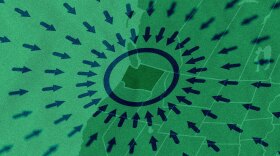If you’re an early riser, you may get to see a total eclipse of the moon on Saturday. The full moon will fall into a dark shadow in the hours just before dawn.
The northwestern U.S. gets a better view of this eclipse than the rest of the mainland states – that is, if you’re not fogged in.
A lunar eclipse is when Earth casts its shadow onto the moon. This will be a total eclipse meaning, the moon will be entirely in earth’s shadow. Bernie Bates, an astronomy professor at the University of Puget Sound, says it gives the moon an unusual color (as you can see in the above photo from the previous eclipse).
“It becomes this incredibly deep reddish brown. You would think going into an eclipse that there would be no light, that it would become completely black, but some light filters through Earth's atmosphere.”
A different way to see the moon
That brown light allows us to see the full moon in a way that’s normally obscured:
“It actually does look like a little round marble. It's one of the most amazing things -- you actually can see that it’s a three-dimensional object.”
A total lunar eclipse happens every few years – always on a full moon. The next one is in April 2014. They’re much easier to experience than an eclipse of the sun, because they're visible from a wide section of Earth (whereas the shadow of a solar eclipse usually falls on a narrow strip of land).
This lunar eclipse one will be at its peak during the hour between 6 and 7 a.m. It’s likely there will be some low clouds and fog at that hour, so you best chance to see it is to get on top of a hill, with a view facing west.
On the Web:







